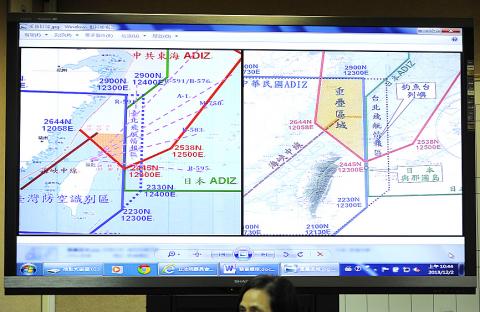|
Lawmakers briefed on
China’s air zone
KEEPING TRACK: The Chinese have sent military
planes into the zone 55 times since Nov. 23, coming very close to either US or
Japanese military aircraft three times
Staff writer, with CNA

Maps showing the overlapping air
defense identification zones of Taiwan, China and Japan are displayed during a
meeting of the legislature’s Foreign Affairs and National Defense Committee in
Taipei yesterday.
Photo: Chen Chih-chu, Taipei Times
Since China announced an air defense
identification zone (ADIZ) over the East China Sea, there have been 13 sightings
of US military aircraft in the zone and 85 instances of Japanese aircraft
entering the zone, a senior military official told lawmakers yesterday.
Deputy Chief of the General Staff for Intelligence Ke Wen-an (柯文安) made the
remarks at a meeting of the legislature’s Foreign Affairs and National Defense
Committee during which officials were asked to give assessments of the situation
following the declaration of the ADIZ on Nov. 23.
The zone includes the Diaoyutai Islands (釣魚台), which are claimed by Taiwan,
China and Japan — which calls them the Senkaku Islands. China has demanded that
foreign aircraft passing through the zone file flight plans in advance and
strictly follow instructions from its air-traffic controllers.
Citing information collected by the military, Ko said China has sent its
military aircraft to the area 55 times since it announced the new zone and there
were three instances in which the Chinese planes were in close proximity to
aircraft from Japan or the US.
The planes were very close to each other, Ko reiterated, when Democratic
Progressive Party (DPP) Legislator Hsiao Bi-khim (蕭美琴) asked whether China had
intercepted any foreign aircraft in the zone.
Minister of National Defense Yen Ming (嚴明) told the committee that no Chinese
military aircraft have entered Taiwan’s ADIZ since Beijing’s Nov. 23
announcement.
Responding to questions from lawmakers on the committee earlier in the day,
Civil Aeronautics Administration Director-General Jean Shen (沈啟) said that
aircraft from Taiwan had previously been intercepted by Japan’s Air Self-Defense
Force in an area where the two countries’ airspace zones overlap.
In 2002, Japanese defense craft “monitored” a Taiwanese plane testing a new air
route designated B591, which stretches from Taipei to northeastern China through
the overlapping zones, according to CAA official Margaret Hong (洪美雲).
A similar incident occurred in 2009, she said.
Shen said the area falls between longitude 123? and 124? east.
Japan asked Taiwan to provide flight plans through the overlap starting in 2009,
and Taiwan has complied, she said.
However, Japanese self-defense planes have intercepted Taiwanese civil aircraft
in the region, which “poses a great danger” to Taiwan’s flight control, she
said.
Hsiao said interference from Japanese fighter planes can seriously impact the
safety of Taiwan’s civil aircraft on normal flight routes.
Hong told reporters after the hearing that “interception” is a military term
meaning that the Japanese fighter was dispatched to “learn about the situation”
and she did not know how close the two planes had come to one another.
Additional reporting by Rich Chang
|
![]()
![]()
![]()